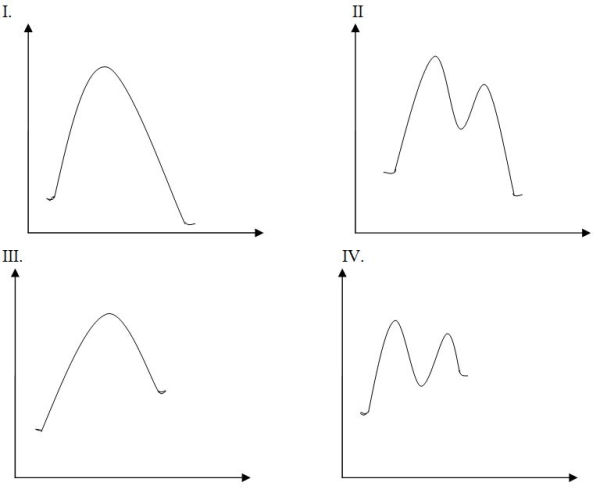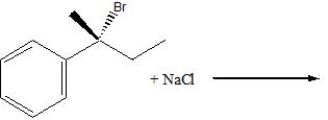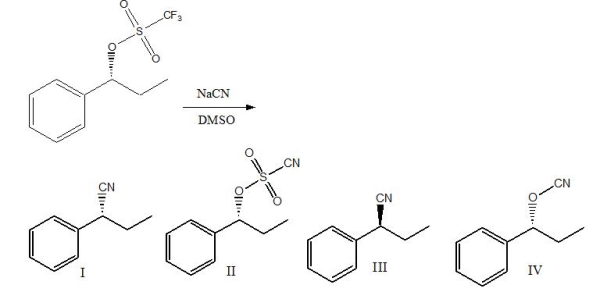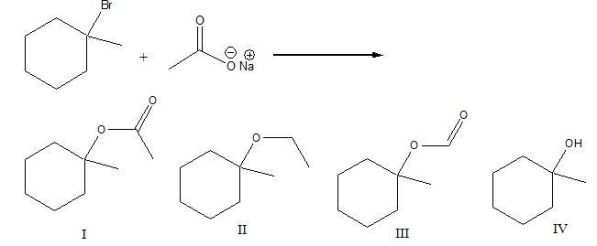A) it is a reaction in which bond breaking occurs first
B) it is a reaction in which all bond-breaking and bond-forming occurs at the same time
C) it is a reaction in which bond forming occurs first
D) it is a substitution reaction
Correct Answer

verified
Correct Answer
verified
Multiple Choice
Draw the potential energy diagram for the following reaction. 

A) I
B) II
C) III
D) IV
E) V
Correct Answer

verified
Correct Answer
verified
Multiple Choice
Rank the following compounds from most to least reactive in an SN2 reaction. 
A) I>IV>II>III
B) II>I>IV>III
C) III>IV>I>II
D) IV>I>II>III
E) IV>III>I>II
Correct Answer

verified
Correct Answer
verified
Multiple Choice
Provide the reagents necessary to carry out the following conversion. 
A) NaOH in water
B) NaOH in ether
C) H2O
D) CH3OH
Correct Answer

verified
Correct Answer
verified
Essay
Predict the product(s) for the following reaction. 
Correct Answer

verified
Correct Answer
verified
Multiple Choice
Which of the following is a strongest nucleophile in a polar protic solvent?
A) F-
B) Cl-
C) Br-
D) I-
E) All of these
Correct Answer

verified
Correct Answer
verified
Multiple Choice
Consider the following SN2 reaction,  Assuming no other changes, what is the effect on the rate, if the concentration of NaN3 is tripled?
Assuming no other changes, what is the effect on the rate, if the concentration of NaN3 is tripled?
A) No effect
B) It would double the rate
C) It would triple the rate
D) It would increase four times
E) It would increase the rate six times
Correct Answer

verified
Correct Answer
verified
Multiple Choice
Which of the following is a substitution reaction? 
A) I
B) II
C) III
D) IV
Correct Answer

verified
Correct Answer
verified
Short Answer
Provide the reagents necessary to carry out the following conversion. 
Correct Answer

verified
Correct Answer
verified
Multiple Choice
Predict the major product for the following reaction. 
A) I
B) II
C) III
D) Both II & IV
E) Both I & III
Correct Answer

verified
Correct Answer
verified
Multiple Choice
Predict the product for the following reaction. 
A) I
B) II
C) III
D) IV
E) I & III
Correct Answer

verified
Correct Answer
verified
Multiple Choice
Predict the product for the following SN1 reaction. 
A) I
B) II
C) III
D) IV
Correct Answer

verified
Correct Answer
verified
Multiple Choice
Predict the product for the following SN1 reaction. 
A) I
B) II
C) III
D) IV
Correct Answer

verified
Correct Answer
verified
Essay
Provide a curved arrow mechanism for the following reaction. 
Correct Answer

verified
Correct Answer
verified
Multiple Choice
When drawing a curved arrow mechanism, the head of the arrow goes to____.
A) the bond that is being formed
B) the bond that is being broken
C) the source of electrons that is being moved
D) the location to which the electrons are being moved
Correct Answer

verified
Correct Answer
verified
Multiple Choice
What is the electrophile in the following reaction? 
A) I
B) II
C) III
D) IV
Correct Answer

verified
Correct Answer
verified
Multiple Choice
What is the IUPAC name for the following compound? 
A) 2-Bromo-4-pentylhexane
B) (2S,4S) -2-Bromo-4,5-diethylheptane
C) 3,4-Diethyl-6-bromoheptane
D) 2-Bromo-4-methylhexane
E) (2R,4R) -2-Bromo-4,5-diethylheptane
Correct Answer

verified
Correct Answer
verified
Multiple Choice
What substitution reaction mechanism is most likely for the following conversion? 
A) SN1
B) SN2
C) Either SN1 or SN2
D) None of these
Correct Answer

verified
Correct Answer
verified
Essay
Provide a curved arrow mechanism for the following reaction 
Correct Answer

verified
Correct Answer
verified
Multiple Choice
Which of the following is the rate equation for the following reaction? 2-chloro-2-methylpentane + NaI ![Which of the following is the rate equation for the following reaction? 2-chloro-2-methylpentane + NaI A) Rate = k[NaI] B) Rate = k[2-chloro-2-methylpentane] [NaI] C) Rate = k[chloride ion] D) Rate = k[2-chloro-2-methylpentane]](https://d2lvgg3v3hfg70.cloudfront.net/TB3185/11eab459_a6c2_6c68_acdb_df548bb1399a_TB3185_00.jpg)
A) Rate = k[NaI]
B) Rate = k[2-chloro-2-methylpentane] [NaI]
C) Rate = k[chloride ion]
D) Rate = k[2-chloro-2-methylpentane]
Correct Answer

verified
Correct Answer
verified
Showing 21 - 40 of 123
Related Exams